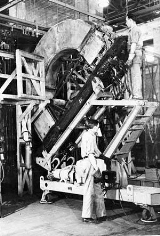
Calutron
Encyclopedia
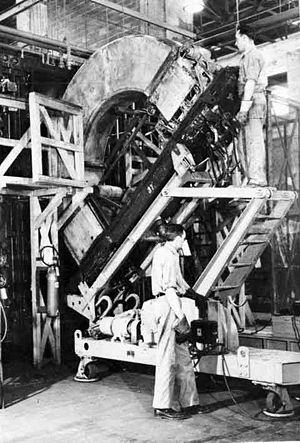
Isotope separation
Isotope separation is the process of concentrating specific isotopes of a chemical element by removing other isotopes, for example separating natural uranium into enriched uranium and depleted uranium. This is a crucial process in the manufacture of uranium fuel for nuclear power stations, and is...
of uranium
Uranium
Uranium is a silvery-white metallic chemical element in the actinide series of the periodic table, with atomic number 92. It is assigned the chemical symbol U. A uranium atom has 92 protons and 92 electrons, of which 6 are valence electrons...
. It was developed by Ernest O. Lawrence during the Manhattan Project
Manhattan Project
The Manhattan Project was a research and development program, led by the United States with participation from the United Kingdom and Canada, that produced the first atomic bomb during World War II. From 1942 to 1946, the project was under the direction of Major General Leslie Groves of the US Army...
and was similar to the cyclotron
Cyclotron
In technology, a cyclotron is a type of particle accelerator. In physics, the cyclotron frequency or gyrofrequency is the frequency of a charged particle moving perpendicularly to the direction of a uniform magnetic field, i.e. a magnetic field of constant magnitude and direction...
invented by Lawrence. Its name is a concatenation
Concatenation
In computer programming, string concatenation is the operation of joining two character strings end-to-end. For example, the strings "snow" and "ball" may be concatenated to give "snowball"...
of Cal. U.-tron, in tribute to the University of California
University of California
The University of California is a public university system in the U.S. state of California. Under the California Master Plan for Higher Education, the University of California is a part of the state's three-tier public higher education system, which also includes the California State University...
, Lawrence's institution and the contractor of the Los Alamos
Los Alamos National Laboratory
Los Alamos National Laboratory is a United States Department of Energy national laboratory, managed and operated by Los Alamos National Security , located in Los Alamos, New Mexico...
laboratory. They implemented industrial scale uranium enrichment at the Oak Ridge
Oak Ridge, Tennessee
Oak Ridge is a city in Anderson and Roane counties in the eastern part of the U.S. state of Tennessee, about west of Knoxville. Oak Ridge's population was 27,387 at the 2000 census...
Y-12
Y-12 National Security Complex
The Y-12 National Security Complex is a United States Department of Energy National Nuclear Security Administration facility located in Oak Ridge, Tennessee, near the Oak Ridge National Laboratory...
plant established during the war and provided much of the uranium used for the "Little Boy
Little Boy
"Little Boy" was the codename of the atomic bomb dropped on Hiroshima on August 6, 1945 by the Boeing B-29 Superfortress Enola Gay, piloted by Colonel Paul Tibbets of the 393rd Bombardment Squadron, Heavy, of the United States Army Air Forces. It was the first atomic bomb to be used as a weapon...
" nuclear weapon
Nuclear weapon
A nuclear weapon is an explosive device that derives its destructive force from nuclear reactions, either fission or a combination of fission and fusion. Both reactions release vast quantities of energy from relatively small amounts of matter. The first fission bomb test released the same amount...
, which was dropped on Hiroshima
Hiroshima
is the capital of Hiroshima Prefecture, and the largest city in the Chūgoku region of western Honshu, the largest island of Japan. It became best known as the first city in history to be destroyed by a nuclear weapon when the United States Army Air Forces dropped an atomic bomb on it at 8:15 A.M...
in 1945.
In a mass spectrometer, a vaporized sample is bombarded with high energy electrons, which cause the sample components to become positively charged ions. They are then accelerated and subsequently deflected by magnetic field
Magnetic field
A magnetic field is a mathematical description of the magnetic influence of electric currents and magnetic materials. The magnetic field at any given point is specified by both a direction and a magnitude ; as such it is a vector field.Technically, a magnetic field is a pseudo vector;...
s, ultimately colliding with a plate and producing a measurable electric current
Electric current
Electric current is a flow of electric charge through a medium.This charge is typically carried by moving electrons in a conductor such as wire...
. Since the ions of the different isotopes have the same electric charge but different masses, the heavier isotopes are bent less by the magnetic field, causing the beam of particles to separate out into several beams by mass, striking the plate at different locations. The mass
Mass
Mass can be defined as a quantitive measure of the resistance an object has to change in its velocity.In physics, mass commonly refers to any of the following three properties of matter, which have been shown experimentally to be equivalent:...
of the ions can be calculated according to the strength of the field and the charge of the ions. An ordinary mass spectrometer is designed to analyse the composition of very small samples; the calutron uses the same principle, but is designed to separate substantial quantities of known isotopes.
Initially a type of calutron later called Alpha was used; it enriched uranium to about 15% 235U. Another type, called Beta, was later designed to further enrich the output of Alpha, optimising the design for the smaller quantities of already enriched feedstock.
Due to the wartime copper shortage the electromagnets were made using thousands of tons of silver borrowed from the U.S. Treasury. To take full advantage of the required large electromagnet, multiple calutrons were arranged around it in a large oval
Oval
An oval is any curve resembling an egg or an ellipse, such as a Cassini oval. The term does not have a precise mathematical definition except in one area oval , but it may also refer to:* A sporting arena of oval shape** a cricket field...
, called a race track
Race track
A race track is a purpose-built facility for racing of animals , automobiles, motorcycles or athletes. A race track may also feature grandstands or concourses. Some motorsport tracks are called speedways.A racetrack is a permanent facility or building...
because of its shape.
Calutrons use very substantial amounts of electrical power. It is estimated that calutrons built in Iraq
Iraq
Iraq ; officially the Republic of Iraq is a country in Western Asia spanning most of the northwestern end of the Zagros mountain range, the eastern part of the Syrian Desert and the northern part of the Arabian Desert....
by the Baath regime of Sadam Hussein required about 140MW for 90 calutrons.
Magnetic separation was later abandoned in favor of the more complicated, but more effective, gaseous diffusion
Gaseous diffusion
Gaseous diffusion is a technology used to produce enriched uranium by forcing gaseous uranium hexafluoride through semi-permeable membranes. This produces a slight separation between the molecules containing uranium-235 and uranium-238 . By use of a large cascade of many stages, high separations...
method.
Uranium isotope separation
The world did not lack methods for separating isotopeIsotope
Isotopes are variants of atoms of a particular chemical element, which have differing numbers of neutrons. Atoms of a particular element by definition must contain the same number of protons but may have a distinct number of neutrons which differs from atom to atom, without changing the designation...
s when it discovered the possible utility of a kilogram of uranium-235
Uranium-235
- References :* .* DOE Fundamentals handbook: Nuclear Physics and Reactor theory , .* A piece of U-235 the size of a grain of rice can produce energy equal to that contained in three tons of coal or fourteen barrels of oil. -External links:* * * one of the earliest articles on U-235 for the...
(235U). Known techniques, pursued simultaneously in Germany
Germany
Germany , officially the Federal Republic of Germany , is a federal parliamentary republic in Europe. The country consists of 16 states while the capital and largest city is Berlin. Germany covers an area of 357,021 km2 and has a largely temperate seasonal climate...
and the United States
United States
The United States of America is a federal constitutional republic comprising fifty states and a federal district...
, included ultra-centrifugation
Ultracentrifuge
The ultracentrifuge is a centrifuge optimized for spinning a rotor at very high speeds, capable of generating acceleration as high as 2,000,000 g . There are two kinds of ultracentrifuges, the preparative and the analytical ultracentrifuge...
, diffusion
Diffusion
Molecular diffusion, often called simply diffusion, is the thermal motion of all particles at temperatures above absolute zero. The rate of this movement is a function of temperature, viscosity of the fluid and the size of the particles...
across thermal or osmotic pressure barriers, and deflection in electric and magnetic fields. The last method appealed to Lawrence, who had made his reputation on the precise control of beams of charged particles. The principle is simple: when passing between the poles of a magnet, a monoenergetic beam of ions of naturally occurring uranium splits into several streams according to their momentum, one per isotope, each characterized by a particular radius of curvature; collecting cups at the ends of the semicircular trajectories catch the homogeneous streams.
Most physicists in 1941 doubted that electromagnetic separation would succeed in practice because they expected that the mutual repulsion of the like-charged ions (the space charge
Space charge
Space charge is a concept in which excess electric charge is treated as a continuum of charge distributed over a region of space rather than distinct point-like charges...
effect) would prevent the formation of narrow beams. But Lawrence, who had seen a line of positively charged ions pour from his cyclotron, had the 37-inch (94 cm) cyclotron modified to demonstrate the feasibility of electromagnetic separation of uranium isotopes using the principle of the mass spectrograph. "It will not be a calamity," he wrote Compton, if uranium turned out to have no military applications; but if "fantastically positive and we fail to get them first, the results for our country may well be a tragic disaster." By December 1941 the uranium ion beam was passing 5 microamperes to the collector; a small amount, but enough to assure Lawrence that space charge would not be a formidable problem.
The fact that beams of uranium ions could be concentrated well enough to yield small quantities of isotope
Isotope
Isotopes are variants of atoms of a particular chemical element, which have differing numbers of neutrons. Atoms of a particular element by definition must contain the same number of protons but may have a distinct number of neutrons which differs from atom to atom, without changing the designation...
s suitable for laboratory research by no means assured that electromagnetic separation could be worked on the industrial scale necessary to make a kilogram of 235U. The process has little to work on, only the slight difference in mass: 1.25 percent-between uranium 235 and 238. Because the lighter ions respond slightly more to the magnetic field than the heavier, their trajectories bend in a tighter arc. At the end of their semicircular travel, the ions of 235U are more plentiful on the inside than on the outside of the beam. But the maximum separation even in the ideal case is small, only one-tenth inch for an arc with a diameter of 37 inches (94 cm). Actual beams are far from ideal.
The alpha calutron
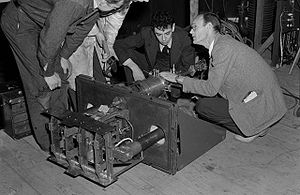
Electric arc
An electric arc is an electrical breakdown of a gas which produces an ongoing plasma discharge, resulting from a current flowing through normally nonconductive media such as air. A synonym is arc discharge. An arc discharge is characterized by a lower voltage than a glow discharge, and relies on...
s were contrived to ionize the uranium tetrachloride
Uranium tetrachloride
Uranium tetrachloride is compound of uranium in oxidation state +4. It was used in the electromagnetic isotope separation process of uranium enrichment. It is one of the main starting materials for organouranium chemistry.- Synthesis :...
feed. Ways were devised to extract the enriched uranium that collected at the receiver, and the still valuable feed material that condensed along with chloride
Chloride
The chloride ion is formed when the element chlorine, a halogen, picks up one electron to form an anion Cl−. The salts of hydrochloric acid HCl contain chloride ions and can also be called chlorides. The chloride ion, and its salts such as sodium chloride, are very soluble in water...
"gunk" all over the inside of the tank. Scrapers were made to clean the exit slits of the feed sources regularly to prevent the accumulated "crud" from reducing beam strength. Lawrence's optimistic conclusion: by the fall of 1942 ten calutrons, each with a 100-milliampere source and all operating within the 184-inch field, would produce four grams of enriched uranium
Enriched uranium
Enriched uranium is a kind of uranium in which the percent composition of uranium-235 has been increased through the process of isotope separation. Natural uranium is 99.284% 238U isotope, with 235U only constituting about 0.711% of its weight...
a day. The S-1 Uranium Committee
S-1 Uranium Committee
The S-1 Uranium Committee was a Committee of the National Defense Research Committee that succeeded the Briggs Advisory Committee on Uranium and later evolved into the Manhattan Project.- World War II begins :...
that oversaw the uranium project for Office of Scientific Research and Development
Office of Scientific Research and Development
The Office of Scientific Research and Development was an agency of the United States federal government created to coordinate scientific research for military purposes during World War II. Arrangements were made for its creation during May 1941, and it was created formally by on June 28, 1941...
recommended expending $12 million to create a plant with 25 times that capacity before the fall of 1943. Lawrence did not doubt that other means, particularly reactor production of fissile
Fissile
In nuclear engineering, a fissile material is one that is capable of sustaining a chain reaction of nuclear fission. By definition, fissile materials can sustain a chain reaction with neutrons of any energy. The predominant neutron energy may be typified by either slow neutrons or fast neutrons...
plutonium
Plutonium
Plutonium is a transuranic radioactive chemical element with the chemical symbol Pu and atomic number 94. It is an actinide metal of silvery-gray appearance that tarnishes when exposed to air, forming a dull coating when oxidized. The element normally exhibits six allotropes and four oxidation...
, might ultimately be the most efficient way to a bomb. But in mid-1942 no reactor worked, and the calutron did.
The calutron design settled on in 1942, called "alpha," provided for enrichment of natural uranium to about 15 percent 235U. Much effort went into designing powerful ion sources and aptly shaped, eventually parabolic
Parabola
In mathematics, the parabola is a conic section, the intersection of a right circular conical surface and a plane parallel to a generating straight line of that surface...
collecting slots. The many modifications and security codes proliferated whimsical names: sources Plato, Cyclops, Bicyclops, and Goofy mated with receivers Gloria, Irene, Mona, or Zulu. Ions from Plato and his friends traversed an arc 48 inches (1.22 m) in radius to reach collector slits placed 0.6 inch (15 mm) apart. The guiding magnetic field was shimmed not by the old black art, but in obedience to calculations. Accurately machined and installed, the shims greatly increased the usable beam that reached the collectors.
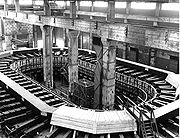
Scaling up at Oak Ridge
Among results obtained with the 184-inch magnet was a design superior to it for large-scale calutrons, the so-called "XA." The prototype of the magnets to be installed at Oak RidgeOak Ridge National Laboratory
Oak Ridge National Laboratory is a multiprogram science and technology national laboratory managed for the United States Department of Energy by UT-Battelle. ORNL is the DOE's largest science and energy laboratory. ORNL is located in Oak Ridge, Tennessee, near Knoxville...
, XA was a rectangular, three-coil magnet giving a horizontal field in which the calutron tanks could stand side-by-side. It had room for four alpha tanks, each with a double source. By the spring of 1943, convinced that the Germans might be ahead, General Leslie Groves
Leslie Groves
Lieutenant General Leslie Richard Groves, Jr. was a United States Army Corps of Engineers officer who oversaw the construction of the Pentagon and directed the Manhattan Project that developed the atomic bomb during World War II. As the son of a United States Army chaplain, Groves lived at a...
decided to skip the scheduled pilot plant: procedures for alpha operation at Oak Ridge came from the XA and a scale model of the production magnet alone. Tests of the first full-scale system installed there, the XAX, were scheduled for July.
The spring and early summer of 1943 brought hundreds of trainees to Berkeley from Tennessee Eastman Company
Eastman Chemical Company
Eastman Chemical Company is a United States based chemical company, engaged in the manufacture and sale of chemicals, fibers, and plastics. Eastman has 11 manufacturing sites in seven countries, supplying its products throughout the world...
, the operator for the Oak Ridge plant. The Laboratory labored to ensure that the test XA magnet system and alpha units were working by April in spite of delays in delivery of steel. Between April and July the training sessions ran continuously. In June a migration that by 1944 would reach 200 started for Oak Ridge. Laboratory expenditures exceeded half a million dollars a month.
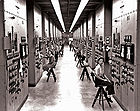
University of California, Berkeley
The University of California, Berkeley , is a teaching and research university established in 1868 and located in Berkeley, California, USA...
workers at Oak Ridge had to see that the XAX magnet worked. Then runs could begin on the first production system, or "racetrack;" a 24-fold magnification of the XA that could hold 96 calutron alpha tanks. To minimize magnetic losses and steel
Steel
Steel is an alloy that consists mostly of iron and has a carbon content between 0.2% and 2.1% by weight, depending on the grade. Carbon is the most common alloying material for iron, but various other alloying elements are used, such as manganese, chromium, vanadium, and tungsten...
consumption, the assembly was curved into an oval 122 feet (37 m) long, 77 feet (23 m) wide and 15 feet (4.6 m) high. Want of copper for the large coils to produce the magnetic fields prompted a solution possible only in wartime: Groves borrowed 14,700 short ton
Short ton
The short ton is a unit of mass equal to . In the United States it is often called simply ton without distinguishing it from the metric ton or the long ton ; rather, the other two are specifically noted. There are, however, some U.S...
s (13,300 tonne
Tonne
The tonne, known as the metric ton in the US , often put pleonastically as "metric tonne" to avoid confusion with ton, is a metric system unit of mass equal to 1000 kilograms. The tonne is not an International System of Units unit, but is accepted for use with the SI...
s, 429 million troy ounce
Troy ounce
The troy ounce is a unit of imperial measure. In the present day it is most commonly used to gauge the weight of precious metals. One troy ounce is nowadays defined as exactly 0.0311034768 kg = 31.1034768 g. There are approximately 32.1507466 troy oz in 1 kg...
s) of pure silver from a government vault for the purpose; all was later returned, the last few tons in 1970. Late in the summer of 1943 the XAX was ready for testing. After a week of difficulty, it cleared the hurdle for full-scale racetrack runs.
The first two of five projected racetracks started up in November and failed from contaminated cooling oil; the second was limping in January, but produced 200 grams of uranium enriched to 12 percent 235U by the end of February 1944, its fifth of the total goal of one kilogram of enriched uranium per month. By April four racetracks were functioning, including the repaired number 1. They required constant attention. Many people from the Laboratory helped modify the units to reach production goals.
The calutrons were initially operated by scientists from Berkeley to remove bugs and achieve a reasonable operating rate. Then Tennessee Eastman operators who had only a high school education took over. Kenneth Nichols
Kenneth Nichols
Kenneth David "Nick" Nichols was a United States Army officer and an engineer. He worked on the Manhattan Project which developed the Atomic Bomb during World War II as Deputy District Engineer and then District Engineer of the Manhattan Engineer District...
compared unit production data, and pointed out to Ernest Lawrence
Ernest Lawrence
Ernest Orlando Lawrence was an American physicist and Nobel Laureate, known for his invention, utilization, and improvement of the cyclotron atom-smasher beginning in 1929, based on his studies of the works of Rolf Widerøe, and his later work in uranium-isotope separation for the Manhattan Project...
that the young “hillbilly” girl operators were outproducing his Ph.Ds. They agreed to a production race and Lawrence lost, a morale boost for the Tennessee Eastman workers and supervisors. The girls were trained like soldiers not to reason why, while “the scientists could not refrain from time-consuming investigation of the cause of even minor fluctuations of the dials” Responsibility for operation passed entirely to Tennessee Eastman after the spring of 1944, and the Laboratory staff at Oak Ridge turned their attention to redesigning the calutron system for higher efficiency.
The beta calutron
Many at the Laboratory, especially Edward Lofgren and Martin KamenMartin Kamen
Martin David Kamen , a physicist inside the Manhattan project. Together with Sam Ruben, he co-discovered the isotope carbon-14 on February 27, 1940, at the University of California Radiation Laboratory, Berkeley....
, thought that a second stage would be necessary to reach the required enrichment. Groves approved the idea. In the spring of 1943, during training at Berkeley for alpha operations, design began on the second or beta stage. Because beta would have only the enriched product of alpha as feed, it would process proportionately less material; its beam therefore did not need to be as broad, nor its dimensions as large, as alpha's. Beta design emphasized recovery, not only of the further enriched output but also of the already enriched feed. The first units were tried at Oak Ridge in late February 1944, but the sources had to be redesigned, and even by June difficulties persisted in recovering the precious beta feed strewn throughout the calutron. Process efficiencies stayed low: only 4 or 5 percent of the 235U in the feed ended up in the output. A better source of enriched uranium feed would have to be found to create the 10 kilograms or so of 90 percent 235U that Robert Oppenheimer
Robert Oppenheimer
Julius Robert Oppenheimer was an American theoretical physicist and professor of physics at the University of California, Berkeley. Along with Enrico Fermi, he is often called the "father of the atomic bomb" for his role in the Manhattan Project, the World War II project that developed the first...
thought necessary for a bomb.
The gaseous diffusion
Gaseous diffusion
Gaseous diffusion is a technology used to produce enriched uranium by forcing gaseous uranium hexafluoride through semi-permeable membranes. This produces a slight separation between the molecules containing uranium-235 and uranium-238 . By use of a large cascade of many stages, high separations...
procedure for separation of uranium isotopes, which had consumed more money than the calutron, had not met its design goals by late 1944. Groves decided that it could not be counted on to produce high enrichment, and that whatever it did produce would have to be supplemented with other less enriched uranium and processed through beta calutrons. To augment the calutron feed, the Manhattan Engineering District constructed a further plant at Oak Ridge, this one working by thermal diffusion
Thermal diffusion
Thermal diffusion may refer to:* Thermal diffusion, an obsolete method of uranium enrichment* Brownian motion .* Diffusion in a temperature gradient ....
, a method developed by Philip Abelson
Philip Abelson
Philip Hauge Abelson was an American physicist, a scientific editor, and a science writer.-Life:Abelson was born in 1913 in Tacoma, Washington. He attended Washington State University where he received degrees in chemistry and physics, and the University of California, Berkeley , where he earned...
.
Weapons-grade uranium
In the critical production period in the first months of 1945, the calutrons, particularly the six betas of 36 tanks each, produced weapons-grade 235U using feed from the modified alpha calutrons, the small output from the gaseous diffusion plant, and whatever the new thermal process had to offer. Virtually all the 235U sent by courier on the train to ChicagoChicago
Chicago is the largest city in the US state of Illinois. With nearly 2.7 million residents, it is the most populous city in the Midwestern United States and the third most populous in the US, after New York City and Los Angeles...
and on to Los Alamos, New Mexico
Los Alamos, New Mexico
Los Alamos is a townsite and census-designated place in Los Alamos County, New Mexico, United States, built upon four mesas of the Pajarito Plateau and the adjoining White Rock Canyon. The population of the CDP was 12,019 at the 2010 Census. The townsite or "the hill" is one part of town while...
had passed through the beta calutrons. From these shipments Oppenheimer's physicists assembled the bomb that was to destroy Hiroshima
Hiroshima
is the capital of Hiroshima Prefecture, and the largest city in the Chūgoku region of western Honshu, the largest island of Japan. It became best known as the first city in history to be destroyed by a nuclear weapon when the United States Army Air Forces dropped an atomic bomb on it at 8:15 A.M...
.
Modern calutrons
After the 1990 Gulf WarGulf War
The Persian Gulf War , commonly referred to as simply the Gulf War, was a war waged by a U.N.-authorized coalition force from 34 nations led by the United States, against Iraq in response to Iraq's invasion and annexation of Kuwait.The war is also known under other names, such as the First Gulf...
, UNSCOM determined that Iraq had been pursuing a calutron program to enrich uranium. Iraq chose to develop the program over more modern, economic, and efficient methods of enrichment because it would require fewer imports.
Calutron patents
The main Calutron patents are Methods of and apparatus for separating materials (Ernest O. Lawrence), Magnetic shims (Robert OppenheimerRobert Oppenheimer
Julius Robert Oppenheimer was an American theoretical physicist and professor of physics at the University of California, Berkeley. Along with Enrico Fermi, he is often called the "father of the atomic bomb" for his role in the Manhattan Project, the World War II project that developed the first...
and Stanley Frankel), and Calutron system (Ernest O. Lawrence).

